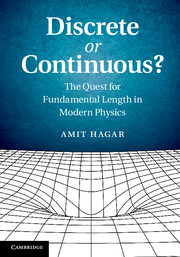Crossref Citations
This Book has been
cited by the following publications. This list is generated based on data provided by Crossref.
Albrecht, Andreas
Retzker, Alex
and
Plenio, Martin B.
2014.
Testing quantum gravity by nanodiamond interferometry with nitrogen-vacancy centers.
Physical Review A,
Vol. 90,
Issue. 3,
Pinna, Simonluca
2015.
The philosophy of quantum gravity – lessons from Nicolai Hartmann.
European Journal for Philosophy of Science,
Vol. 5,
Issue. 3,
p.
279.
Ippoliti, Emiliano
2016.
Model-Based Reasoning in Science and Technology.
Vol. 27,
Issue. ,
p.
119.
Crouse, David T.
2016.
The lattice world, quantum foam and the universe as a metamaterial.
Applied Physics A,
Vol. 122,
Issue. 4,
Gudder, S.
2017.
Reconditioning in Discrete Quantum Field Theory.
International Journal of Theoretical Physics,
Vol. 56,
Issue. 12,
p.
3838.
Spallucci, Euro
and
Smailagic, Anais
2017.
Regular black holes from semi-classical down to Planckian size.
International Journal of Modern Physics D,
Vol. 26,
Issue. 07,
p.
1730013.
Benatti, F.
Floreanini, R.
Olivares, S.
and
Sindici, E.
2017.
Noisy effects in interferometric quantum gravity tests.
International Journal of Quantum Information,
Vol. 15,
Issue. 08,
p.
1740014.
Peruzzi, Giulio
and
Rocci, Alessio
2018.
Tales from the prehistory of Quantum Gravity.
The European Physical Journal H,
Vol. 43,
Issue. 2,
p.
185.
Farr, Robert S.
and
Fink, Thomas M. A.
2019.
Phase transition creates the geometry of the continuum from discrete space.
Physical Review E,
Vol. 100,
Issue. 2,
Freire Junior, Olival
2019.
David Bohm.
p.
119.
Gubbiotti, Giorgio
2020.
Lagrangians and integrability for additive fourth-order difference equations.
The European Physical Journal Plus,
Vol. 135,
Issue. 10,
Hagar, Amit
2020.
Quantum, Probability, Logic.
p.
305.
Baek, Seungju
and
Choi, Younggi
2020.
A Historical and Mathematical Study on Continuum - Focusing on the Composition and Infinite Division -.
The Korean Society of Educational Studies in Mathematics - Journal of Educational Research in Mathematics,
Vol. 30,
Issue. 4,
p.
575.
Crowther, Karen
2021.
Defining a crisis: the roles of principles in the search for a theory of quantum gravity.
Synthese,
Vol. 198,
Issue. S14,
p.
3489.
Gubbiotti, Giorgio
2021.
Quantum Theory and Symmetries.
p.
67.
Jirovsky, Vaclav
and
Jirovsky, Vaclav
2021.
Advances in Artificial Intelligence, Software and Systems Engineering.
Vol. 271,
Issue. ,
p.
55.
Hansen, Casper Storm
2021.
Founding Mathematics on Semantic Conventions.
Vol. 446,
Issue. ,
p.
169.
Loke, Andrew
2022.
The Teleological and Kalam Cosmological Arguments Revisited.
p.
195.
Nash, Lewis
2022.
On the Dynamics of Euclidean Space–Time at the Planck Scale.
Reports in Advances of Physical Sciences,
Vol. 06,
Issue. ,
Gubbiotti, G.
2022.
Classification of variational multiplicative fourth-order difference equations.
Journal of Difference Equations and Applications,
Vol. 28,
Issue. 3,
p.
406.





